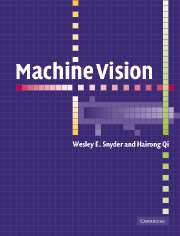Book contents
- Frontmatter
- Contents
- To the instructor
- Acknowledgements
- 1 Introduction
- 2 Review of mathematical principles
- 3 Writing programs to process images
- 4 Images: Formation and representation
- 5 Linear operators and kernels
- 6 Image relaxation: Restoration and feature extraction
- 7 Mathematical morphology
- 8 Segmentation
- 9 Shape
- 10 Consistent labeling
- 11 Parametric transforms
- 12 Graphs and graph-theoretic concepts
- 13 Image matching
- 14 Statistical pattern recognition
- 15 Clustering
- 16 Syntactic pattern recognition
- 17 Applications
- 18 Automatic target recognition
- Author index
- Index
17 - Applications
Published online by Cambridge University Press: 05 June 2012
- Frontmatter
- Contents
- To the instructor
- Acknowledgements
- 1 Introduction
- 2 Review of mathematical principles
- 3 Writing programs to process images
- 4 Images: Formation and representation
- 5 Linear operators and kernels
- 6 Image relaxation: Restoration and feature extraction
- 7 Mathematical morphology
- 8 Segmentation
- 9 Shape
- 10 Consistent labeling
- 11 Parametric transforms
- 12 Graphs and graph-theoretic concepts
- 13 Image matching
- 14 Statistical pattern recognition
- 15 Clustering
- 16 Syntactic pattern recognition
- 17 Applications
- 18 Automatic target recognition
- Author index
- Index
Summary
Example isn't another way to teach, it is the only way to teach
Albert EinsteinMachine vision has found a wide set of applications from astronomy [17.44] to industrial inspection, to automatic target recognition. Itwould be impossible to cover them all in the detail which they deserve. In this chapter, we choose to provide the reader with more of an annotated bibliography than a pedagogical text. We mention a few applications very briefly, and provide a few references. In the next chapter, we choose one application discipline, automatic target recognition, to cover in a bit more detail.
Multispectral image analysis
The strategy of multispectral image analysis combines spatial and spectral representations in a representation in which each pixel is a vector, an ordered set of measurements. Color, where the elements of the vector are [r, g, b], is the obvious example, and there is a great deal of work in the literature in color processing. Most of the reported work has been intended for image quality enhancement. Only some recent papers elaborate on the use of color for recognition [17.14, 17.18, 17.53, 17.58].
The methods we have studied for univariate images, for example using Markov random field methods to remove noise, are applicable to multispectral images [17.3]. Often, all that is necessary is to use a vector description instead of scalar pixels.
Optical character recognition (OCR)
Despite our love for this topic and the huge number of papers devoted (e.g., in this paragraph, we cite only a few references [16.1, 17.32, 17.64]), we cannot take the space to cover it in the kind of detail it deserves.
- Type
- Chapter
- Information
- Machine Vision , pp. 382 - 391Publisher: Cambridge University PressPrint publication year: 2004



